
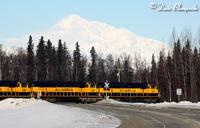 |
The first mixed train to run on the ARR in
over three decades is crossing the Talkeetna spur road and beginning to
slow for its scheduled station stop. Rising behind the train is the 20,320
ft summit of Mt. McKinley, the highest peak in North America. From head
to rear this 2300+ ft train consists of 3 SD70MACs, 13 passenger coaches,
7 53 ft COFC flats, and 10 loaded tank cars of diesel fuel. MP 225.7, Talkeetna.
March 14, 2009 |
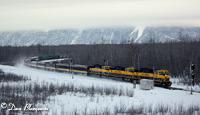 |
The first mixed train to run on
the ARR in over three decades is highballing north at track speed rolling
through the junction at NSS
Matanuska (MP
151.4 on the ARR mainline). Three SD70MACs lead a 2300 ft train consisting
of 13 coaches (with 120 paying passengers), 7 COFC flats, and 10 loaded
tank cars of diesel fuel. The ARR is exercising an FRA waiver to run mixed
trains allowing it to consolidate some traffic and operate as efficiently
and cost effectively as possible. The ARR is always an innovator and not
afraid to look to the past for solutions to problems in the present. Matanuska
Junction. |
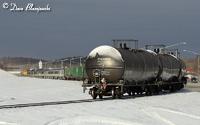 |
A going away look at the tail end of the first mixed train to run on
the ARR in over three decades as it slows for its pending station stop.
Three SD70MACs lead a 2300 ft train consisting of 13 coaches (with 120
paying passengers), 7 COFC flats, and 10 loaded tank cars of diesel fuel.
The ARR is exercising an FRA waiver to run mixed trains allowing it to
consolidate some traffic and operate as efficiently and cost effectively
as possible. The ARR is always an innovator and not afraid to look to the
past for solutions to problems in the present. MP 158.9, Wasilla |
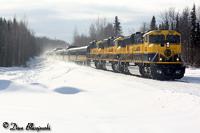 |
The first mixed train to run on the ARR in over three decades is highballing
north at track speed as it leans into the curve a couple miles south of
Montana siding. Three SD70MACs lead a 2300 ft train consisting of 13 coaches
(with 120 paying passengers), 7 COFC flats, and 10 loaded tank cars of
diesel fuel. The ARR is exercising an FRA waiver to run mixed trains allowing
it to consolidate some traffic and operate as efficiently and cost effectively
as possible. The ARR is always an innovator and not afraid to look to the
past for solutions to problems in the present. Parks Hwy Crossing - MP 206.3,
Montana |
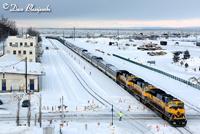 |
In an historic first, due to changing traffic
patterns the ARR has chosen to exercise its FRA waiver to run mixed trains
consisting of revenue passenger and haz-mat freight traffic. On this Saturday
morning the first one is being readied for departure. Three SD70MACs pull
north across C Street to head out of town for the 356 mile journey to Fairbanks.
Trailing the power are 13 coaches (inflated this day by charter equipment
deadheading north) and 17 freight cars (7 COFC loads and 10 loads of diesel
fuel) on Passenger track 1. The 120 passengers aboard this day are about
to become a part of history as the past becomes prologue in Alaska! Beyond
the train can be seen the icy blue waters of Cook Inlet and then the mighty
peaks of the Alaska Range 80 miles distant. Anchorage |
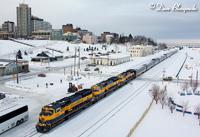 |
In an historic first, due to changing traffic
patterns the ARR has chosen to exercise its FRA waiver to run mixed trains
consisting of revenue passenger and haz-mat freight traffic. On this Saturday
morning the first one is being readied for departure. Three SD70MACs lead
13 coaches as they shove back to couple to 17 freight cars (7 COFC loads
and 10 loads of diesel fuel). The 120 passengers aboard this day are about
to become a part of history as the past becomes prologue in Alaska! Anchorage |
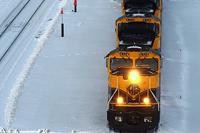 |
Getting ready to pull out of Passenger Track
1 at the Anchorage Depot |
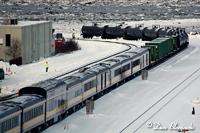 |
Rear of train as built on Passenger Track 1
showing mixed passenger and freight consist. |
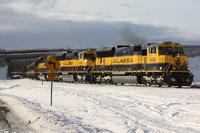 |
Coming into Wasilla passing under the Palmer-Wasilla
Hwy. bridge. Looking directly opposite the going away shot that you have
as the third one down on your page. |
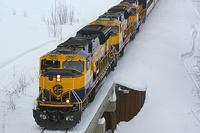 |
Crossing over Lily Creek Bridge at MP 182.5
in Nancy Lake. |
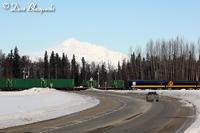 |
Crossing the Talkeetna Spur Rd at MP 225.7
with Mt. McKinley in background. |
Note: the photographer is a railroad
employee and was wearing all required personal protective equipment. The
ARRC does not permit the general public on to their private property without
permission. |
Mixed train line-up:
Locomotives: 4324, 4326, 4318
Passenger cars: 208, 207, 523, 210, 209, 352, 300, 401, 100 (baggage),
301, 206, 205, 103 (baggage)
COFC/TOFC: 12992, 12907, 12902, 12001, 12941, 12960, 12905
Tank cars (ITLX): 225052, 225026, 225002, 224994, 224969, 225035,
224982, 225034, 224945, 225020
On 3/30/09 Robert Krol added, "The ARR ran a mixed train
in the early 90's. Whittier ran out of fuel and the ARR tacked on 3 or 5 tank
cars and 5 gondolas for spacers to the end of the Princess Cruise Train to Whittier.
Don't have any photos though. When we were unloading the train a passenger asked
me if the fuel was suppose to be on their train. I told him Whittier ran out
of fuel and the ARR has the correct number of spacer cars to occupied cars."
On 4/14/09 Dave Kocher added, "I noticed the mixed passenger/freight
train article added on March 30, and it has not been over three decades since
we last did this. I was the station agent at Denali Park the summer of 1983.
We still ran "regular" trains in those days; Numbers 1 and 2 were
the express passenger trains, and Numbers 5 and 6 were the three round trip
per week local trains that ran up to Fairbanks one day, and back to Anchorage
the next. These local trains almost always had freight cars added, I believe
they could handle up to 25 cars. Needless to say, they couldn't keep their schedule.
It didn't affect Number 5 that much between Fairbanks and Denali Park, but Number
6 was routinely over an hour late (there was a scheduled crew change at Healy),
which made it difficult to plan anything for the nights of its three runs per
week. I think this continued until around 1985. I'm sure it was over when they
quit running Numbers 5 and 6 to Fairbanks and ran the Hurricane Turn passenger
train instead."
BACK
Page created 3/30/09 and last updated 4/19/09
©
2009 David Blazejewski unless otherwise noted

